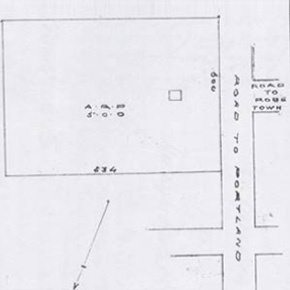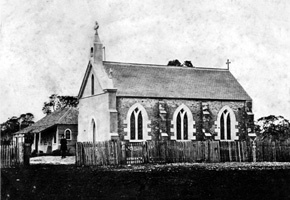Penola’s Early Catholic History
The genesis of Catholic ministry and education in Penola was inextricably linked with the settlement of the district and the foundation of the town by Highland Scots from the Lochaber region of Inverness-shire.
Alexander Cameron, the first to arrive, applied for a 48 square mile occupation license on 19 December 1845, [1] and he had converted his original homestead into the Royal Oak Hotel by 23 November 1848. [2] In March of the same year, the roving Vicar General, Father Michael Ryan, made his first visit to the district.
On 14 February 1850, Cameron bought at auction a land grant of 80 acres comprising Section 3 County of Grey that he had recently had surveyed. Four days later, he leased 20 acres of it to Alexander Anderson, on the condition that the latter ‘engages to fence in the same and put up substantial buildings for carrying on a store.’ [3] Cameron’s freehold title was not actually issued until the following month, on 4 April 1850. [4]
Anderson moved swiftly and had completed his store, the second dwelling in the settlement, [5] by 31 May 1850, when he advertised in The Portland Guardian that he ‘begs to inform his friends, the Settlers and others, of the New Country, that he has just opened the [Penola Store]’. [6] It was located on the east side of Portland Street, directly opposite the road to Robe (now Riddoch Street), on the site of the 1872 Catholic presbytery that later became the convent.
On 5 March 1851 Cameron agreed to sell five acres of this lease ‘attached to the store’ [7] to Anderson, but the business failed, the title reverted to Cameron, and the store was leased by Robert Muir, and then George Gladstone.[8] By 1854 Gladstone had built a new store across Portland Street on Allotment 108, which later became known as Cobb & Co.

This acquisition was in preparation for the arrival later in the year, on 30 November 1854, of the first resident priest, Father Peter Powell, whose ‘zeal, energy and untiring exertions [were] much esteemed by all classes of society.’ [12] He would occupy ‘two small rooms’ in the building, [13]and on Sunday 3 December (coincidentally the day of the Eureka Rebellion) [14] conducted his first service in the shop area of the old store, which held ‘about 20 or 30 people and was larger than ever the congregation required.’ [15]
In the following month of January 1855 he established a Catholic school, under his own ‘immediate inspection and patronage’ [16] ‘in a hut adjoining the store’, [17] of which Michael O’Grady was the teacher. O’Grady was clearly competent, and he also applied for a government teacher’s license later in the year, on 17 October, which was granted on 28 November 1855. This was the first such license in the South East, and guaranteed him an annual SA Board of Education stipend of about £32, but obliged him to ‘watch the morals, punctuality and cleanliness’ of his pupils. [18] He continued to teach throughout 1856 but resigned at the end of the school year. However, he stayed in Penola for a time because he knew the second resident priest, the Reverend Julian Edmund Tenison Woods, who arrived on the Feast of Saint Joseph, 19 March 1857. O’Grady subsequently went to the Victorian gold fields, and was teaching at Steiglitz, near Geelong, from 9 January 1858 until that school closed on 26 May 1858. [19]
Woods was unable to obtain another teacher until 1861, when 25 year-old Isabella Johnston opened a cottage school for him in nearby Petticoat Lane. [20] Isabella left to be married in November 1863, and was succeeded by her younger sister, Matilda, until she also married, aged 18, in November 1865. [21]
Woods continued the missionary work of his predecessor, only taking up intermittent residence in two small rooms at the store during his ten years in the district, [22] as he was constantly travelling throughout his 22,000 square mile (57,000 square kilometre) parish. However, the year after his arrival he initiated the building of a church in Penola, between the store and Portland Street, and in March 1859 it was reported that:
The new stone Catholic Church is rapidly approaching completion, and I understand will be opened for divine service on Sabbath week. The beautiful little edifice, with its neat belfry, is quite an ornament to our ‘bonnie little town’. Much credit is due to the Rev Mr Woods, the young priest, for his indefatigable exertions, and also to a certain wealthy settler for the reality. [23]
The young priest conducted his first service in St Joseph’s Church on Easter Sunday, 24 April 1859, [24] and his congregation was joined in the following year by 18 year-old Mary MacKillop, governess to the children of her uncle, the wealthy squatter Alexander Cameron, at Penola Station. [25] Woods and MacKillop discussed the founding of a teaching order at this time, but it would not become a reality until Mary returned to Penola in January 1866, after the departure of the Johnston sisters. Mary later wrote that ‘the first St Joseph’s school…had its origin in a six-stalled stable’ [26] which was located at the corner of Queen and Bowden Streets. [27] There were 33 pupils in attendance by 19 March when, as she recalled, ‘…we first kept up St Joseph’s day as the special feast of our proposed Institute, and little did either of us then dream of what was to spring from so small a beginning.’ [28]

On the Feast of the Presentation, 21 November 1866, Woods gave Mary a short Rule to follow, and addressed her as ‘Sister’. [29] Meanwhile, the new stone schoolhouse near the church was under construction. It was completed in time for the examinations held on 15 June 1867, when the examiners were well satisfied with the progress of the children. [30]
Anderson’s old store was still standing nearby. In its time it had served as a presbytery, a chapel, and a school, surviving until 1872, when it was reported that:
One of the oldest institutions of the township has disappeared, namely St Joseph’s Presbytery, and in its place we now see a handsome stone mansion – a very great improvement on the old dilapidated wooden building existing for so many years. There was however, one pleasing association attached to the old building, namely, that it was the first place in this township where public worship was held, in fact we may say it was the place where the first footstep of civilization was stamped in the South Eastern District. [31]
This new stone presbytery is extant today, on the exact site of Anderson’s old store, although it later became a convent for the Sisters of Saint Joseph. [32] The St Joseph’s Church that Woods built in 1859 survived, well buttressed, for 65 years until it was demolished in 1924 and replaced by the present edifice.
Peter Rymill, ‘Penola’s Early Catholic History’, Penola Historical Selections Volume 7, ed. Margaret Muller, Penola Branch National Trust SA, Penola 2010
References
1. State Records of South Australia, GRG 35/4, 14.2.1846
2. SA Government Gazette, 23.11.1848
3. SA Old Systems Land Titles, 3.37
4. SA Old Systems Land Titles, 428.69
5. The Border Watch, 5.8.1871
6. The Portland Guardian, 31.5.1850
7. SA Old Systems Land Titles, 1.37
8. The South-Eastern Star, 17.5.188
9. Indenture plan dated 10 June 1854 between Alexander Cameron Junior of Penola and The Right Reverend Francis Murphy of Adelaide. Number 34 Book 71, SA Old System Land Titles Office, Adelaide
10. SA Old Systems Land Titles, 34.71: Indenture and Conveyance from Alexander Cameron Junior of Penola to Francis Murphy Bishop of Adelaide, as to 5 acres of Section 3 for £300, dated 10.6.1854.
11. Mary MacKillop, Julian Tenison Woods – A Life, Blackburn 1997, p38
12. The Portland Guardian, 11.1.1855
13. JET Woods, Personal Reminiscences of Adam Lindsay Gordon, Melbourne Review, April 1884, p133
14. Pam O’Connor, 150 Years of Catholicism in Penola and District, Penola 2004, p3
15. JET Woods, Memoirs, to Anne Bulger, chapter 7, p12
16. The Portland Guardian, 11.1.1855
17. George O’Neill SJ, Life of the Rev Julian Edmund Tenison Woods, Sydney 1929, p90
18. Peter Rymill, The Early History of the Penola Primary School, in Penola Historical Selections Volume V, Penola 1993, p37
19. MDHC, Catholic Archdiocese of Melbourne
20. The cottage was that of William Smith on Allotment 155, between the Church Land and Sharam’s Cottage.
21. Elizabeth Macilwain, The Johnston Family in Penola, in Penola Historical Selections Volume VI, Penola 2003, p110.
22. JET Woods, Personal Reminiscences of Adam Lindsay Gordon, Melbourne Review, April 1884, p133
23. The Adelaide Register, 5.3.1859
24. George O’Neill SJ, Life of the Rev Julian Edmund Tenison Woods, Sydney 1929, p91
25. Paul Gardiner SJ, Mary MacKillop, Newtown 1993, p40
26. Mary MacKillop, History of the Congregation, Resource Material from The Archives of the Sisters of Saint Joseph of the Sacred Heart, Issue No 3, Sydney 1984, p3. Lottie McKay mentions in The Border Watch (21.9.1939) that they were ‘old training stables’. It is possible they housed the racehorses of John Bowden, who conducted the nearby Prince of Wales Hotel between November 1860 to November 1861. (PHS Vl p64)
27. The stable was situated on Allotment 58, owned by William McDonald. It is now a memorial park.
28. Mary MacKillop, Mother Mary’s Circulars to the Sisters, North Sydney 1976, p168
29. Paul Gardiner, op cit, p59, citing Recollections of Blanche Amsinck (Sister Francis Xavier), Mother House Archives, 1.2.1926
30. The Border Watch, 19.6.1867
31. The Border Watch, 23.5.1872 32. The Sisters lived there from 1882 to 1885 after the priests moved to Naracoorte. They returned for 1889 and again in 1936 when they opened the new St Joseph’s School, now the Mary MacKillop Memorial School.



